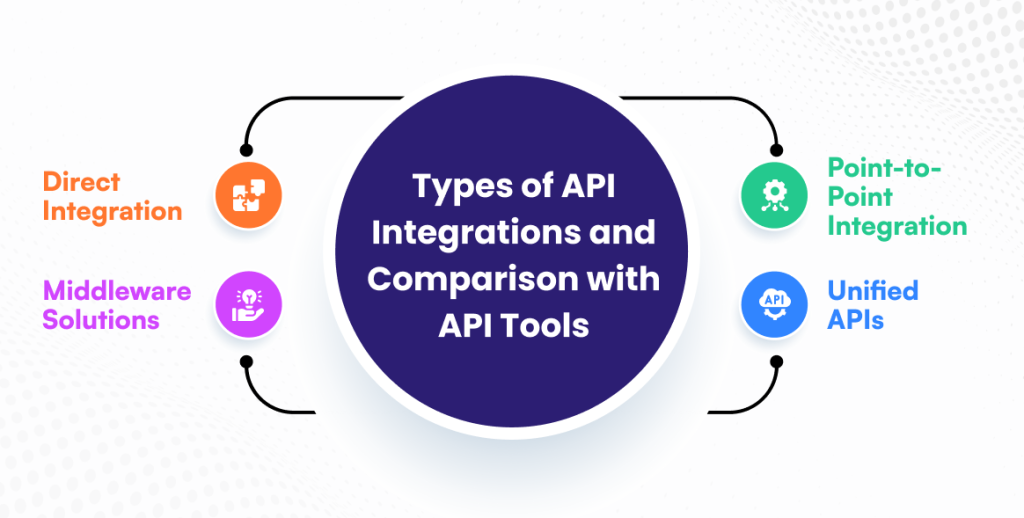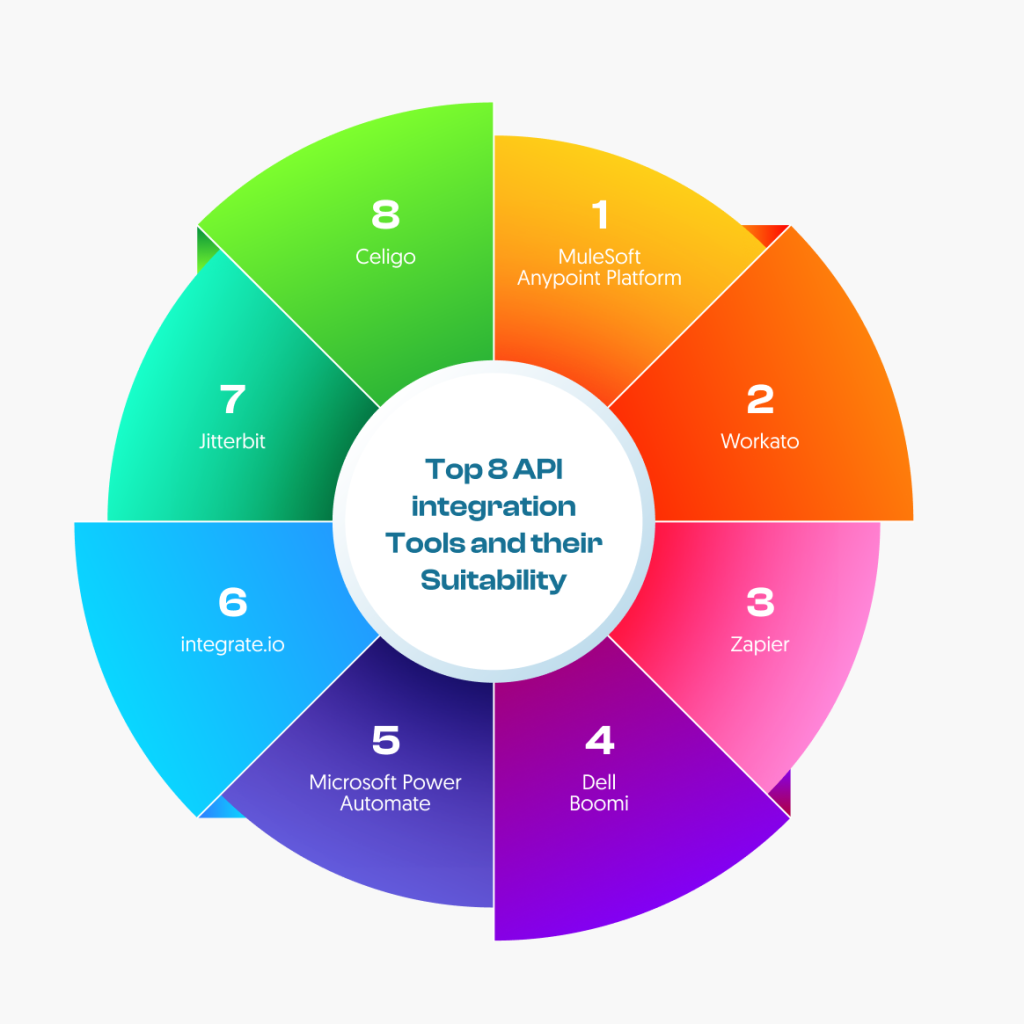
API Integration Tools: Complete Guide with A List of Top 8 Tools
As soon as Open AI cracked the code of developing intelligent chatbot and released ChatGPT, that was amazing at understanding human natural language. Businesses fell head over heels to get it API so that they can integrate this AI capability into their software product and make it more potent.
This is the importance of APIs. They not only facilitate bringing the latest functionalities into your business with ease without investing heavily in your in-house development. Thus, you innovate faster and stay competitive in the cutthroat environment.
So, whether it is operational agility, or business scalability, or even exceptional user experience, API integration does the job. However, it is easier said than done. You need to be well-informed of your options and possibilities before you find the right way to integrate the right APIs.
For this we have brought this guide on API integration tools, exploring API as the concept and its benefits, various integrations and how tools outperform the other integration methods.
Plus, we share the top 8 API integration tools showcasing their capabilities and suitability, so you find the right pick for your specific business needs. Let’s start.
What Are API Integrations and Their Business Value Additions

API, or Application Programming Interface, integrations is, basically, connecting different software systems. It acts as bridge between the two giving them a common ground to exchange data even if they are made using different technologies. Additionally, it also makes sure that the security of the two systems is not compromised while it fills the gap between the two.
It brings different benefits to the business.
Significant Interoperability Between Fragmented Business Systems
API allows different software systems to work together. For businesses this can be for internal software system communication or external communication to fetch specialized capabilities.
For example, the different departments in a business such marketing, sales, human resources use specialized software systems to operate. Now, although they work for the same organization but if they maintain separate data with overlapping entries it might lead to chaos. However, API integrations can bring these siloed software systems together to operate in tandem.
Similarly, for businesses seeking some specialized function for their software product, APIs can do wonders. The above-mentioned example of ChatGPT falls into this exact category.
Also Read : PHP for Enterprise Web Development: Break Barriers For Limitless Efficiency
Create a Secure Communication System
The next big thing in the line is Security. This is arguably the second-most important benefit of API integration.
APIs contribute to the security of both systems that are involved in integration. It acts as a controlled gateway to systems and exposes only the necessary endpoints while protecting the sensitive internal functions. They also follow security protocols and follow recognized practices like data encryption so that it is not compromised during the transmission.
On top of it, it helps the API providing admins to monitor usage patterns so that suspicious activities can be detected.
However, all of this requires careful management, so if needed never feel shy of connecting with an expert.
Avoiding Error-prone Repetitive Tasks with Smart Automation
APIs are key when it comes to achieving the business empowering capability of automation. When businesses use APIs for integration it helps the internal systems exchange data without manual intervention, automating repetitive, tedious and error-prone tasks.
For e-commerce, APIs will help in automatically updating inventory levels in the inventory management software once a customer makes the purchase on the eCommerce platform of their business.
This brings razor-sharp efficiency into the business that significantly contributes towards market leadership. This is also because it not only improves the operational side of the business it improves the customer side as well – the user experience. Read on.
User Do More with Your Application
With added functionalities into your products and offering, users can do more with your platform.
This enhances their experience with your product while developing a strong trust in your brand. So, whether it is a city map or the flight schedule, or even the payment gateways, they can access all of these within your application. No need for them to hop from one platform to another.
Fostering Innovation and Scalability
More functions and capabilities including third-party services to your app also means you will also be able to scale your business. APIs allow you to quickly implement new features and bring the latest capabilities, like NLPs, to your services.
Also Read : Laravel vs Symfony
Thus, you scale systems to meet dynamic business, customer and market demands without significant redevelopment efforts. You can innovate faster and enrich your user engagement and satisfaction and fuel the growth engine.
Types of API Integrations and Comparison with API Tools

API integrations are achieved through multiple methods. Traditional methods (e.g., SDKs, middleware) offer more customization but often require more resources and technical oversight
Direct Integration Using Software Development Kits (SDKs)
SDKs are highly customized solutions that are good for applications needing close control over their data handling and functionality.
This involves using libraries and code snippets for integration. However, this also means the direct integrations are time-consuming and may lack scalability. So, if you need broad integration wherein you need to connect a wide range of diverse systems and data sources within a single solution, then this method is not suitable one.
API tools facilitate centralized management for all the integration, and they come with pre-built connectors. They do not require custom coding. So, if you need quick integration without investing heavily in developer resources.
Middleware Solutions
There also exist some middleware solutions such as Enterprise Service Buses (ESBs) and Integration Platforms as a Service (iPaaS). They are great for complex environments such as an enterprise where multiple systems like ERP, CRM, among others need to be integrated continuously.
Unlike SDKs, they are good at supporting scalability, however, they require technical expertise for the same.
Again, comparing this with API tools. The tools are typically simpler and easier, making them a good fit for agile, cloud-friendly integrations. Hence, they are good for business looking for such integration while saving on the overhead of traditional middleware.
Also Read : PHP vs Python
Point-to-Point (P2P) Integration
As the name suggests, P2P integration is achieved through a direct link between two specific applications. It typically involves using custom code or simple HTTP requests.
This kind of integration is a cost-effective way to greater customization and control and is great for efficiency and speed while enhancing data accuracy and integrity.
But it is only good for small-scale integrations. For high-scale businesses using P2P integration would mean an unmanageable number of connections, or what is colloquially called “spaghetti” architectures that are a nightmare to scale.
Now, contrasting it with API Tools, they facilitate integration through a central hub, helping you manage multiple APIs without creating separate connections for each one. So, no spaghetti here, for those still wondering.
Unified APIs
These types of API integration are for businesses needing flexibility of accessing across multiple vendors in the same category. For example, a retailer uses different shipping APIs to access multiple services.
Unified API platforms provide a single API as a single endpoint for integration. Thereby doing away with the complexity. However, the challenge with them is that they may be limited to specific categories.
On the other hand, with API Tools integration, you can access a broader range of integrations across categories. Thus, they prove to be a more comprehensive solution for diverse system needs.
Top 8 API integration Tools and their Suitability

MuleSoft Anypoint Platform
It is a comprehensive solution for API integration best for large enterprises. This is because it offers robust integration capabilities essential to serve the complex integration need of such enterprise. Along with that it comes with strong support and extensive connectivity options with myriad API management features.
So, if you are run a financial institution, healthcare organizations, and any other businesses that seek high-performance, reliability, and scalability in their integrations, this is the way to go.
Workato
If you don’t want to or can’t afford to invest in expert developers for their integration, Workato is a user-friendly option. The interface is simple and easy, but automation capabilities including those powered with AI are great. It comes with pre-built connectors that strongly focus on business users.
It is best for mid-market businesses with a keen focus on automation and something that even non-technical users can also work upon.
Zapier
The no-code approach makes it best for small businesses, start-ups and individuals. Moreover, it offers a wide range of pre-built integrations including simple automation.
The users can automate routine tasks between different applications and improve their productivity.
Dell Boomi
This is a cloud-based iPaaS made to serve mid-sized to enterprise businesses. It comprises of a visual development environment, strong integration capabilities, broad options, and API management features.
This brings the needed flexibility and scalability that such businesses need from their integration platform.
Microsoft Power Automate
With the strong reliability of Microsoft, this comes as a part of the Power Platform. Hence, it is great for businesses heavily invested in the Microsoft ecosystem. Automate is a low-code/no-code development with great automation capabilities for Microsoft products.
Integrate.io
This tool really stands out with its enterprise grade capability. Its ETL function, data synchronization and robust data transformation tools make high-scale business operate at a competitive level.
Apparently, this tool is great for enterprises that have complex data integration needs, data analysts, and data engineers.
Jitterbit
Made for mid-market and enterprise business, it brings flexibility and scalability with it. It is essentially a cloud-based iPaaS with visual development environment and strong API management features helping in extensive connectivity.
Celigo
For Salesforce-based businesses, Celigo is a great option that focuses on cloud-based integrations. It also comes with pre-built connectors and is great for user-friendliness. Not to mention the strong support offered by Salesforce.
Conclusion
API integrations are an integral part of modern business. They help business bring innovation and integrate latest capabilities into their software products to stand out competition and stay in lead.
They contribute towards high-level operational functionality, security, automation, user experience and scalability. Further, as we already discussed, there are multiple ways to achieve API integrations, but API tools stand out when it comes to adding value to the business.
By selecting the right tools, you unlock new opportunities for growth and expansion. As it is not only innovation, but they also contribute to better strategies and achieve high efficiency.

